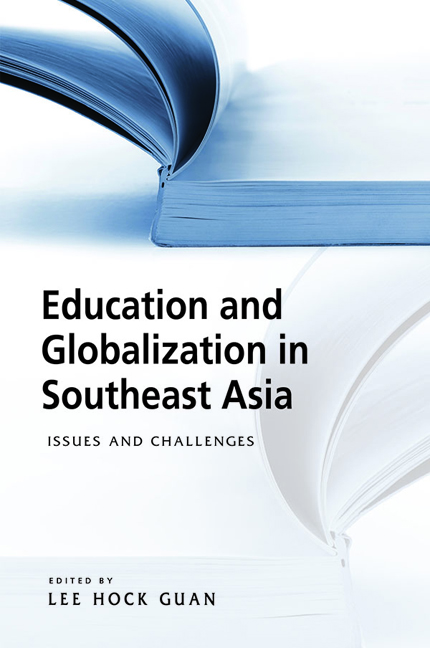Book contents
- Frontmatter
- Contents
- Acknowledgements
- Contributors
- Introduction
- 1 English in Singapore and Malaysia: Common Roots, Different Fruits
- 2 Globalization, Educational Language Policy and Nation-Building in Malaysia
- 3 Second-Order Change Without First-Order Change: A Case of Thai Internationalization of Higher Education
- 4 Higher Education in Malaysia: Access, Equity and Quality
- 5 Indonesian Higher Education: Gaps in Access and School Choice
- 6 Increasing Access to and Retention in Primary Education in Malaysia
- 7 Primary and Secondary Education in Myanmar: Challenges Facing Current Reforms
- Index
3 - Second-Order Change Without First-Order Change: A Case of Thai Internationalization of Higher Education
Published online by Cambridge University Press: 12 January 2018
- Frontmatter
- Contents
- Acknowledgements
- Contributors
- Introduction
- 1 English in Singapore and Malaysia: Common Roots, Different Fruits
- 2 Globalization, Educational Language Policy and Nation-Building in Malaysia
- 3 Second-Order Change Without First-Order Change: A Case of Thai Internationalization of Higher Education
- 4 Higher Education in Malaysia: Access, Equity and Quality
- 5 Indonesian Higher Education: Gaps in Access and School Choice
- 6 Increasing Access to and Retention in Primary Education in Malaysia
- 7 Primary and Secondary Education in Myanmar: Challenges Facing Current Reforms
- Index
Summary
INTRODUCTION
Internationalization of higher education has become a worldwide phenomenon that impacts education systems across contexts, countries and continents. The expansion of the internationalization process and its complexity is well illustrated in the evolution of academic attention paid to the definitions of internationalization. Arguably, the most acclaimed definition was given by Knight (1994) who defines it as the “process of integrating an international and intercultural dimension into the teaching, research and service functions of the institution” (p. 7). This working definition represents one of the first attempts to situate the internationalization process as a central part of every function of higher education institutions. Ten years on, the definition of internationalization of higher education was equated, to better include internationalization'svarying idiosyncratic characteristics; as “the process of integrating an international, intercultural, or global dimension into the purpose, functions or delivery of post-secondary education” (Knight 2003, p. 2). Note the inclusion of the “global dimension” and the changing terminology from “institution” to “post-secondary education”. This revised definition was intended to incorporate the growing diversity of the international process, which has indeed expanded in both its breadth and depth.
To understand the internationalization of higher education and its relationship to policy change, Van der Wende's (1996) framework is useful. According to him, the internationalization of higher education could be viewed as a “process of educational change” that comprises of first-order and second-order changes. The first-order changes mean “those [changes] that improve the effectiveness and efficiency of what is currently done”, while the second-order changes alter the fundamental ways in which organizations are put together, including new goals, structures and roles. (Van der Wende 1996, p. 26) Internationalization of higher education can bring about both first-order and second order changes simultaneously. Examples of second-order changes include preparing students to join the international labour market, establishing special units to facilitate international cooperation and exchange, becoming partners in international alliances, and having performance assessed in accordance with international comparative perspectives (Van der Wende 1996, pp. 26–27, cited in Nilphan 2005, p. 39). Thus Van der Wende's definition of first-order and secondorder change can help researchers assess and analyse the level of policy “success” that internationalization has brought about.
- Type
- Chapter
- Information
- Education and Globalization in Southeast AsiaIssues and Challenges, pp. 59 - 82Publisher: ISEAS–Yusof Ishak InstitutePrint publication year: 2017



